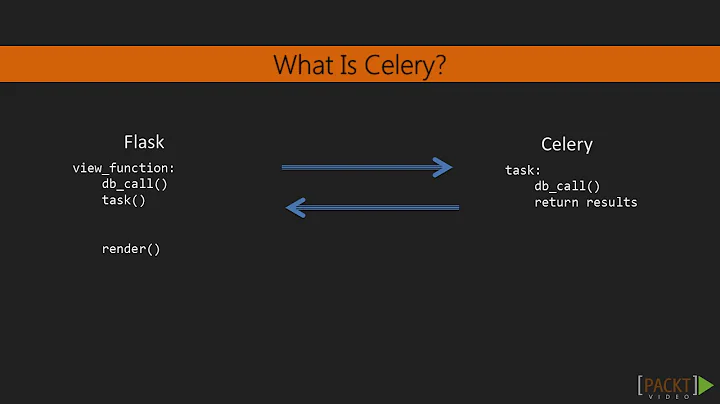Python Flask with celery out of application context
Solution 1
Here is a solution which works with the flask application factory pattern and also creates celery task with context, without needing to use app.app_context(). It is really tricky to get that app while avoiding circular imports, but this solves it. This is for celery 4.2 which is the latest at the time of writing.
Structure:
repo_name/
manage.py
base/
base/__init__.py
base/app.py
base/runcelery.py
base/celeryconfig.py
base/utility/celery_util.py
base/tasks/workers.py
So base is the main application package in this example. In the base/__init__.py we create the celery instance as below:
from celery import Celery
celery = Celery('base', config_source='base.celeryconfig')
The base/app.py file contains the flask app factory create_app and note the init_celery(app, celery) it contains:
from base import celery
from base.utility.celery_util import init_celery
def create_app(config_obj):
"""An application factory, as explained here:
http://flask.pocoo.org/docs/patterns/appfactories/.
:param config_object: The configuration object to use.
"""
app = Flask('base')
app.config.from_object(config_obj)
init_celery(app, celery=celery)
register_extensions(app)
register_blueprints(app)
register_errorhandlers(app)
register_app_context_processors(app)
return app
Moving on to base/runcelery.py contents:
from flask.helpers import get_debug_flag
from base.settings import DevConfig, ProdConfig
from base import celery
from base.app import create_app
from base.utility.celery_util import init_celery
CONFIG = DevConfig if get_debug_flag() else ProdConfig
app = create_app(CONFIG)
init_celery(app, celery)
Next, the base/celeryconfig.py file (as an example):
# -*- coding: utf-8 -*-
"""
Configure Celery. See the configuration guide at ->
http://docs.celeryproject.org/en/master/userguide/configuration.html#configuration
"""
## Broker settings.
broker_url = 'pyamqp://guest:[email protected]:5672//'
broker_heartbeat=0
# List of modules to import when the Celery worker starts.
imports = ('base.tasks.workers',)
## Using the database to store task state and results.
result_backend = 'rpc'
#result_persistent = False
accept_content = ['json', 'application/text']
result_serializer = 'json'
timezone = "UTC"
# define periodic tasks / cron here
# beat_schedule = {
# 'add-every-10-seconds': {
# 'task': 'workers.add_together',
# 'schedule': 10.0,
# 'args': (16, 16)
# },
# }
Now define the init_celery in the base/utility/celery_util.py file:
# -*- coding: utf-8 -*-
def init_celery(app, celery):
"""Add flask app context to celery.Task"""
TaskBase = celery.Task
class ContextTask(TaskBase):
abstract = True
def __call__(self, *args, **kwargs):
with app.app_context():
return TaskBase.__call__(self, *args, **kwargs)
celery.Task = ContextTask
For the workers in base/tasks/workers.py:
from base import celery as celery_app
from flask_security.utils import config_value, send_mail
from base.bp.users.models.user_models import User
from base.extensions import mail # this is the flask-mail
@celery_app.task
def send_async_email(msg):
"""Background task to send an email with Flask-mail."""
#with app.app_context():
mail.send(msg)
@celery_app.task
def send_welcome_email(email, user_id, confirmation_link):
"""Background task to send a welcome email with flask-security's mail.
You don't need to use with app.app_context() here. Task has context.
"""
user = User.query.filter_by(id=user_id).first()
print(f'sending user {user} a welcome email')
send_mail(config_value('EMAIL_SUBJECT_REGISTER'),
email,
'welcome', user=user,
confirmation_link=confirmation_link)
Then, you need to start the celery beat and celery worker in two different cmd prompts from inside the repo_name folder.
In one cmd prompt do a celery -A base.runcelery:celery beat and the other celery -A base.runcelery:celery worker.
Then, run through your task that needed the flask context. Should work.
Solution 2
Flask-mail needs the Flask application context to work correctly. Instantiate the app object on the celery side and use app.app_context like this:
with app.app_context():
celery.start()
Solution 3
I don't have any points, so I couldn't upvote @codegeek's above answer, so I decided to write my own since my search for an issue like this was helped by this question/answer: I've just had some success trying to tackle a similar problem in a python/flask/celery scenario. Even though your error was from trying to use mail while my error was around trying to use url_for in a celery task, I suspect the two were related to the same problem and that you would have had errors stemming from the use of url_for if you had tried to use that before mail.
With no context of the app present in a celery task (even after including an import app from my_app_module) I was getting errors, too. You'll need to perform the mail operation in the context of the app:
from module_containing_my_app_and_mail import app, mail # Flask app, Flask mail
from flask.ext.mail import Message # Message class
@celery.task
def send_forgot_email(email, ref):
with app.app_context(): # This is the important bit!
msg = Message("Recover your Crusade Gaming Account")
msg.recipients = [email]
msg.sender = "Crusade Gaming [email protected]"
msg.html = \
"""
Hello Person,<br/>
You have requested your password be reset. <a href="{0}" >Click here recover your account</a> or copy and paste this link in to your browser: {0} <br />
If you did not request that your password be reset, please ignore this.
""".format(url_for('account.forgot', ref=ref, _external=True))
mail.send(msg)
If anyone is interested, my solution for the problem of using url_for in celery tasks can be found here
Solution 4
In your mail.py file, import your "app" and "mail" objects. Then, use request context. Do something like this:
from whateverpackagename import app
from whateverpackagename import mail
@celery.task
def send_forgot_email(email, ref):
with app.test_request_context():
msg = Message("Recover your Crusade Gaming Account")
msg.recipients = [email]
msg.sender = "Crusade Gaming [email protected]"
msg.html = \
"""
Hello Person,<br/>
You have requested your password be reset. <a href="{0}" >Click here recover your account</a> or copy and paste this link in to your browser: {0} <br />
If you did not request that your password be reset, please ignore this.
""".format(url_for('account.forgot', ref=ref, _external=True))
mail.send(msg)
Related videos on Youtube
Spuds
Updated on September 14, 2022Comments
-
Spuds 3 months
I am building a website using python Flask. Everything is going good and now I am trying to implement celery.
That was going good as well until I tried to send an email using flask-mail from celery. Now I am getting an "working outside of application context" error.
full traceback is
Traceback (most recent call last): File "/usr/lib/python2.7/site-packages/celery/task/trace.py", line 228, in trace_task R = retval = fun(*args, **kwargs) File "/usr/lib/python2.7/site-packages/celery/task/trace.py", line 415, in __protected_call__ return self.run(*args, **kwargs) File "/home/ryan/www/CG-Website/src/util/mail.py", line 28, in send_forgot_email msg = Message("Recover your Crusade Gaming Account") File "/usr/lib/python2.7/site-packages/flask_mail.py", line 178, in __init__ sender = current_app.config.get("DEFAULT_MAIL_SENDER") File "/usr/lib/python2.7/site-packages/werkzeug/local.py", line 336, in __getattr__ return getattr(self._get_current_object(), name) File "/usr/lib/python2.7/site-packages/werkzeug/local.py", line 295, in _get_current_object return self.__local() File "/usr/lib/python2.7/site-packages/flask/globals.py", line 26, in _find_app raise RuntimeError('working outside of application context') RuntimeError: working outside of application contextThis is my mail function:
@celery.task def send_forgot_email(email, ref): global mail msg = Message("Recover your Crusade Gaming Account") msg.recipients = [email] msg.sender = "Crusade Gaming [email protected]" msg.html = \ """ Hello Person,<br/> You have requested your password be reset. <a href="{0}" >Click here recover your account</a> or copy and paste this link in to your browser: {0} <br /> If you did not request that your password be reset, please ignore this. """.format(url_for('account.forgot', ref=ref, _external=True)) mail.send(msg)This is my celery file:
from __future__ import absolute_import from celery import Celery celery = Celery('src.tasks', broker='amqp://', include=['src.util.mail']) if __name__ == "__main__": celery.start()-
Spuds over 9 yearsmail is the flask_mail instance. mail gets initiated from a different file when the app gets started.
-
 Jonas Geiregat over 9 yearsI don't know which solution would be better, adding the context to the whole celery application instance or just the callback function. But you can read all about the Flask Application Context at flask.pocoo.org/docs/appcontext
Jonas Geiregat over 9 yearsI don't know which solution would be better, adding the context to the whole celery application instance or just the callback function. But you can read all about the Flask Application Context at flask.pocoo.org/docs/appcontext
-
-
Spuds over 9 yearsHow do i give celery access to the flask app? I have them in separate files right now, is that wrong?
-
 David K. Hess over 9 yearsImport the app into the celery file like you would do when running Flask. You might have to post your
David K. Hess over 9 yearsImport the app into the celery file like you would do when running Flask. You might have to post your__init__.pyfor your Flask app or include more details of your setup for me to be more specific. -
 Pedro Werneck over 9 yearsHaving the same problem, but instantiating the app and starting the celery inside the context like that isn't working. maybe because the task instance was created outside of the context?
Pedro Werneck over 9 yearsHaving the same problem, but instantiating the app and starting the celery inside the context like that isn't working. maybe because the task instance was created outside of the context? -
 David K. Hess over 9 yearsThis will only work in the current thread. It's possible you have something in running in another thread. Just do the same thing in that one.
David K. Hess over 9 yearsThis will only work in the current thread. It's possible you have something in running in another thread. Just do the same thing in that one. -
 jaapz over 8 yearsI think using test_request_context in a non-test environment is not a pretty good idea.
jaapz over 8 yearsI think using test_request_context in a non-test environment is not a pretty good idea. -
 Dag Høidahl almost 7 yearsThis solved a problem when using Flask-Babel in combination with celery. Flask-Babel won't load any translations without a request (because it caches the translations on the request context). Apart from that, Flask-Babel is able to work fine without the request. So using
Dag Høidahl almost 7 yearsThis solved a problem when using Flask-Babel in combination with celery. Flask-Babel won't load any translations without a request (because it caches the translations on the request context). Apart from that, Flask-Babel is able to work fine without the request. So usingtest_request_context()is just a simple way of constructing a functional context, even though it might be a little wasteful. -
gaozhidf about 3 yearsIt has bothered me for a few days. Thanks a lot
-
Minh Hoàng over 2 yearsWhy need to run two celery processes? Thank you!
-
 Bob Jordan over 2 years@MinhHoàng the
Bob Jordan over 2 years@MinhHoàng thecelery -A base.runcelery: celery beatruns the periodic tasks / cron jobs, only if you have set them up in thebase.celeryconfig.pyfile, specifically refer tobeat_schedulevariable which I have commented out in the example. If you don't need to use any periodic tasks then you do not need to run two celery processes. You can just run thecelery -A base.runcelery: celery workerprocess. -
 Naman over 1 yearDoes the
Naman over 1 yearDoes theinit_celery(app, celery=celery)inside create_app function do anything? -
 Bob Jordan over 1 year@Naman yes it adds the flask application context to celery.Task
Bob Jordan over 1 year@Naman yes it adds the flask application context to celery.Task -
 Matheus Torquato over 1 yearWon't that create a circular import? You would need to import the snippet above from your app, right?
Matheus Torquato over 1 yearWon't that create a circular import? You would need to import the snippet above from your app, right?

